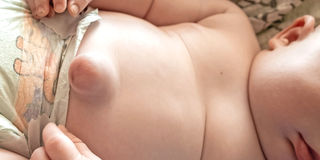Fixing the boy with a ‘window’ to his stomach

The umbilical herniae vary in size, from small, penny-sized ones to saucer-sized ones.
What you need to know:
- After birth, the umbilical cord falls out and the umbilical ring closes during the early months of life
- Failure of this closure results in a direct hernia
- In some instances, the area around the umbilical cord may have a defect within the wall, creating an indirect umbilical hernia
Starting clinical rotations is every medical student’s dream. Being able to walk into the wards in your white coat and listening to a patient telling you about their illness makes you truly believe you are on your way to becoming a doctor.
We knew it was going to be hard work, but we did not anticipate the true meaning of apprenticeship. I shadowed my senior colleagues doggedly all over the wards, pen and notebook in hand, jotting down even the most unimportant of points. I am definitely the doctor I am today because these magnanimous colleagues were tolerant, accepting and generous.
Eleven weeks into my fourth year, our rotations were rudely interrupted by industrial actions by our lecturers due to a pay dispute. The medical school was closed and we were sent home indefinitely. After one week at home, I felt like a rusty old nail. I needed to get back to the wards, so as not to lose the little skills I had gained.
A friend put me in touch with a senior paediatric surgeon at our national hospital and I was able to rotate in the paediatric surgery wards among the resident doctors pursuing their post-graduate training. Within a week, I was trailing one of the resident doctors all over, learning about surgical conditions in children.
Made fun of me
On Wednesdays after rounds, we would admit the children scheduled for surgery for the coming week. This entailed taking a full history and doing a head to toe examination. I was too green to do this on my own, but the resident doctor would involve me throughout the process. He was extremely patient.
One sunny Wednesday, little Isaiah* walked into the doctor’s room accompanied by his father. He was as bright as the weather out there. He liked my watch and asked if he could wear it for a little while. As we chatted with Isaiah, I asked him why he had come to the hospital and he proudly told me the doctor was going to close the window to his stomach because he was now a big boy and did not need it. He was turning six.
Before I could figure out what Isaiah meant, he asked if I wanted to see his "window". He lifted up his shirt and right there in front of me was the biggest navel I had ever seen, popping all out as Isaiah let out a merry laugh. He caught my surprise before I could mask it and together we laughed some more, cementing a friendship that lasted his entire admission.
Isaiah’s navel took me right back to my childhood. I was the odd girl with a popping belly button in kindergarten, it popped right through my dresses and the other kids made fun of me. I kept my cardigan on all day to conceal it, but I was not very successful. Eventually, I accepted it and even named it Poppy. It flattened off in teenage, but never quite sank in.
Having Isaiah in the ward was my golden opportunity to learn about the umbilical hernia. During the development of the baby in the womb, the anterior abdominal wall of the forming baby is formed by the 12th week of pregnancy, leaving a small gap called the umbilical ring, through which the umbilical arteries and vein come through to the placenta.
Intestine perforation
After birth, the umbilical cord falls out and the umbilical ring closes during the early months of life. Failure of this closure results in a direct hernia. In some instances, the area around the umbilical cord may have a defect within the wall, creating an indirect umbilical hernia.
These defects result in intestines popping through the gap and can be felt right under the skin. This is more pronounced when one coughs, sneezes or strains the abdomen because of the increased intra-abdominal pressure. The umbilical herniae vary in size, from small, penny-sized ones to saucer-sized ones.
For most children, the hernia will close naturally by age five. No treatment is required other than observation to pick up the rare instances of complications. If the hernia persists past five years, it should be closed surgically. The complications include trapping of the intestines in the hernia, obstructing blood flow to the incarcerated part of the intestine. This can lead to the intestine perforating, with grave consequences.
Red hearts
For this reason, Isaiah’s hernia was still big at the age of five and he was scheduled to undergo surgery with our team. Though he did not comprehend what surgery really meant, he was good and ready to bid his window goodbye.
He came through surgery like the champ he was and was back to the ward with a wide surgical dressing across his tummy. We had a yellow teddy bear waiting for him in his bed.
Over the next two days, we drew red hearts on this dressing to show him how well he was doing. We celebrated his progress with a huge lollypop when he was permitted to eat and a box of crayons when he walked out of bed to the playroom. On the third day, he hugged us goodbye and walked off to a windowless new life.



